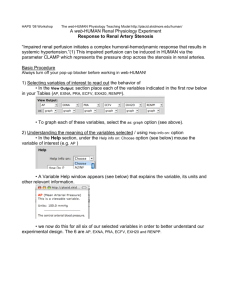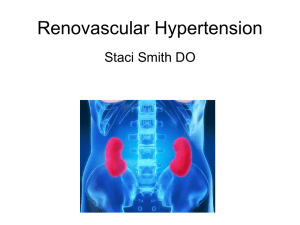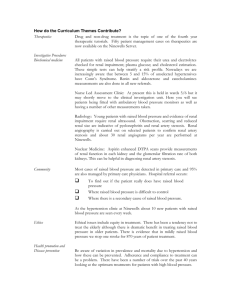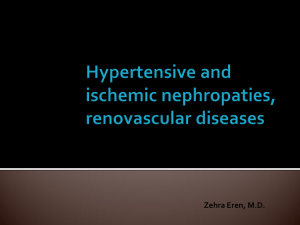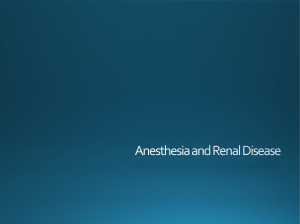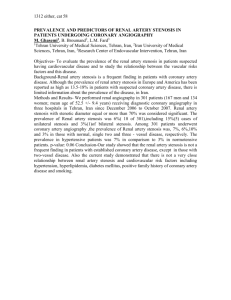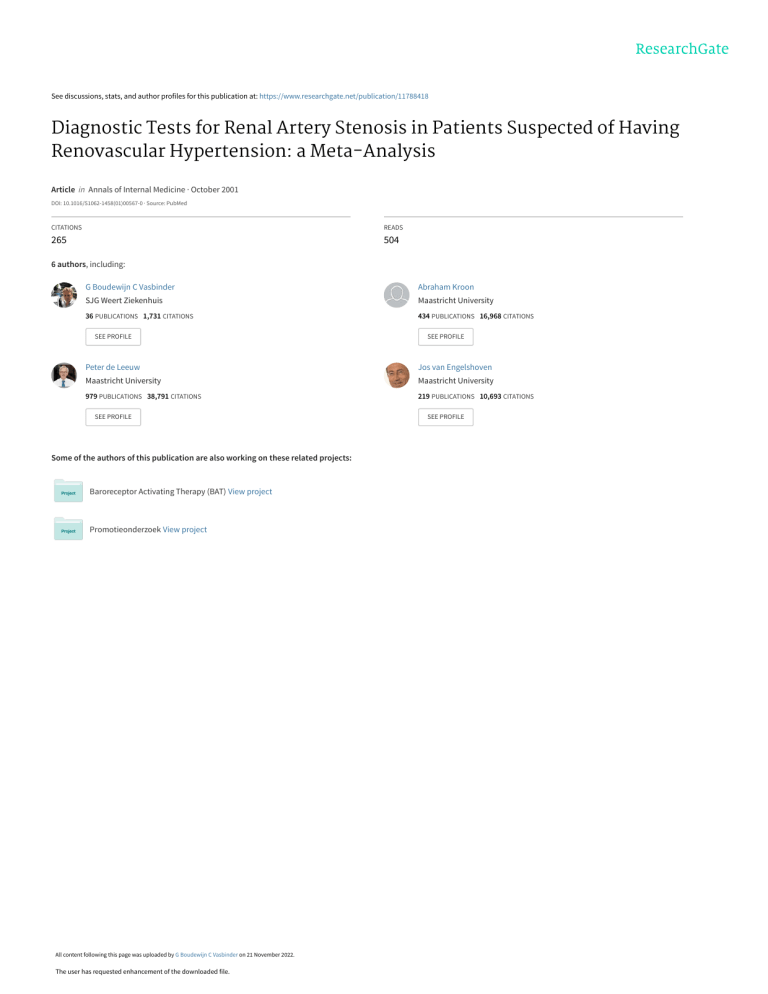
See discussions, stats, and author profiles for this publication at: https://www.researchgate.net/publication/11788418 Diagnostic Tests for Renal Artery Stenosis in Patients Suspected of Having Renovascular Hypertension: a Meta-Analysis Article in Annals of Internal Medicine · October 2001 DOI: 10.1016/S1062-1458(01)00567-0 · Source: PubMed CITATIONS READS 265 504 6 authors, including: G Boudewijn C Vasbinder Abraham Kroon SJG Weert Ziekenhuis Maastricht University 36 PUBLICATIONS 1,731 CITATIONS 434 PUBLICATIONS 16,968 CITATIONS SEE PROFILE SEE PROFILE Peter de Leeuw Jos van Engelshoven Maastricht University Maastricht University 979 PUBLICATIONS 38,791 CITATIONS 219 PUBLICATIONS 10,693 CITATIONS SEE PROFILE Some of the authors of this publication are also working on these related projects: Baroreceptor Activating Therapy (BAT) View project Promotieonderzoek View project All content following this page was uploaded by G Boudewijn C Vasbinder on 21 November 2022. The user has requested enhancement of the downloaded file. SEE PROFILE Article Diagnostic Tests for Renal Artery Stenosis in Patients Suspected of Having Renovascular Hypertension: A Meta-Analysis G. Boudewijn C. Vasbinder, MD; Patricia J. Nelemans, MD, PhD; Alfons G.H. Kessels, MD, MSc; Abraham A. Kroon, MD, PhD; Peter W. de Leeuw, MD, PhD; and Jos M.A. van Engelshoven, MD, PhD Purpose: To summarize and compare the validity of computed tomography angiography, magnetic resonance angiography, ultrasonography, captopril renal scintigraphy, and the captopril test for diagnosis of renal artery stenosis in patients suspected of having renovascular hypertension. Data Sources: For each diagnostic modality, published studies were identified by MEDLINE literature searches. Study Selection: Original studies were selected if they met the following criteria: 1) suspicion of renovascular hypertension was the indication for the test; 2) intra-arterial x-ray angiography was used as the gold standard; 3) a cutoff point for a positive test result was explicitly defined; and 4) absolute numbers of truepositive, false-negative, true-negative, and false-positive results were available or could be derived from the presented data. Data Extraction: A standard form was used to extract relevant data. I n a general hypertensive population, the prevalence of renovascular disease varies between 1% and 5% (1, 2). In patients who exhibit specific clinical clues that indicate renovascular hypertension, the probability of having the disease increases to 20% to 40% (3). Renovascular hypertension is currently treated with drugs; surgery; or less invasive techniques, such as percutanous transluminal renal angioplasty with or without stent placement. A recent study found no significant difference between treatment with percutanous transluminal renal angioplasty and antihypertensive drug therapy. However, in that study, 44% of patients who received drug therapy still received percutanous transluminal renal angioplasty (4). Because a large proportion of patients are still preferably treated with angioplasty, a valid diagnostic test is needed in the presence of one or more clinical clues (5). Intra-arterial x-ray angiography is considered the gold standard; however, it is invasive and carries small risks for serious complications, such as arterial dissection or adverse contrast reactions. During the past few decades, many researchers have reported results of other, less invasive diagnostic tests. It is, however, difficult to compare the tests’ diagnostic Data Synthesis: Data on the accuracy of the different diagnostic methods were analyzed and compared by constructing summary receiver-operating characteristic (ROC) curves and by computing areas under the summary ROC curves. Results: Although accuracy varied greatly for all diagnostic modalities, summary ROC curves found that computed tomography angiography and gadolinium-enhanced, three-dimensional magnetic resonance angiography performed significantly better than the other diagnostic tests. Conclusions: Computed tomography angiography and gadolinium-enhanced three-dimensional magnetic resonance angiography seem to be preferred in patients referred for evaluation of renovascular hypertension. However, because few studies of these tests have been published, further research is recommended. Ann Intern Med. 2001;135:401-411. www.annals.org For author affiliations, current addresses, and contributions, see end of text. performance. Reviews have reported broad ranges of sensitivity and specificity for a certain test that overlap the ranges reported for other tests. Furthermore, studies differ in case-mix, specific test characteristics, and cutoff points for a positive test result, all of which may affect estimates of sensitivity and specificity. The objective of our meta-analysis was to compare five noninvasive or minimally invasive modalities currently used in clinical practice to detect renal artery stenosis. The tests were computed tomography angiography (CTA), magnetic resonance angiography (MRA), ultrasonography, captopril renal scintigraphy, and the captopril test. Intravenous renal angiography and conventional renography were not considered because earlier studies showed that their accuracy was limited (6, 7). METHODS Data Sources We searched MEDLINE using the following terms: magnetic resonance imaging and angiography and (renal artery or hypertension, renovascular); tomography, x-ray computed and angiography and (renal artery or hyperten© 2001 American College of Physicians–American Society of Internal Medicine 401 Article Diagnostic Tests in Renovascular Hypertension sion, renovascular); ultrasonography and angiography and (renal artery or hypertension, renovascular); and captopril and angiography and (renal artery or hypertension, renovascular). No beginning date limit was used. The search was updated until 1 August 2000. Only English-, German-, or French-language studies were considered because the investigators were familiar with these languages. The bibliographies of selected articles were screened for potentially suitable references, which were then retrieved. We also searched the EMBASE and Cochrane databases using the same search strategy. Study Selection Studies were included in the meta-analysis if they met the following criteria: 1) intra-arterial x-ray angiography was used as the gold standard; 2) clinical suspicion of renovascular hypertension was the reason for referral; 3) the criteria and cutoff values for a positive result for each test (for example, hemodynamically significant stenosis) were explicitly defined; and 4) the absolute numbers of true-positive, false-negative, false-positive, and true-negative results were available or could be derived from the data presented. Two investigators screened the full text of potentially relevant articles using the inclusion criteria. In all cases of disagreement, the investigators reached consensus. Studies that included patients who had received renal transplants were excluded. Another reason for exclusion was the possibility of verification bias, which appears when patients with a positive result on the index test (that is, the test under investigation) are referred to the gold standard test more often than patients with a negative result on the index test. The presence of verification bias was assumed if only some of the patients who had the index test were referred for intra-arterial x-ray angiography. If an author or a research group published more than one study about the same diagnostic test, the most recent study was included. All articles by the same author or research group were included for analysis only when it was obvious that a different patient sample had been used. In cases where an author or research group discussed more than one diagnostic technique within one journal article (for example, MRA vs. ultrasonography, or two-dimensional time-of-flight MRA vs. three402 18 September 2001 Annals of Internal Medicine Volume 135 • Number 6 dimensional time-of-flight MRA), each modality was considered separately. Data Extraction We used a standard form to extract relevant data from the included articles. Several studies reported more than one pair of sensitivity and specificity estimates because they used several approaches to analyze data on accuracy. These approaches included inclusion compared with exclusion of the accessory renal arteries in the analysis; estimation of sensitivity and specificity using renal arteries, kidneys, or patients as the unit of analysis; exclusion compared with inclusion of missing observations (such as technical failures, poor examination quality, or arteries not identified at the index test); and presentation of sensitivity and specificity estimates based on evaluation by more than one reviewer. We preferred sensitivity and specificity estimates based on inclusion of accessory renal arteries, on patients as unit of analysis, or on inclusion of missing observations in the analysis. If a study presented results based on more than one reviewer, the accuracy data representing the highest estimates were extracted. For each ultrasonography study, we noted whether measurements were performed at the level of the intrarenal arteries or at the level of the extrarenal arteries. For captopril renal scintigraphy studies, we noted whether the analysis was based on changes between baseline (precaptopril) and postcaptopril measurements or only on postcaptopril measurements. When captopril renal scintigraphy studies presented estimates based on evaluation of postcaptopril renography and captopril-induced changes, the highest estimates were extracted. Data Synthesis We based our meta-analysis method on the construction of summary receiver-operating characteristic (ROC) curves. This method accounts for the mutual dependence between sensitivity and specificity; evaluates the extent to which the variation in sensitivity and specificity can be explained by variation in positivity thresholds among studies; makes it possible to assess the effects of other between-study differences, such as differences in test design and analysis characteristics, on the estimates of diagnostic accuracy; and is very useful in comparing different diagnostic tests (8, 9). Areas under the sumwww.annals.org Diagnostic Tests in Renovascular Hypertension mary ROC curves were used as a measure of the diagnostic performance of the tests. We calculated a diagnostic odds ratio on the basis of the sensitivity and specificity reported in each study and then derived areas under the ROC curves for each study. We used linear regression analyses to compare the diagnostic tests. In these analyses, indicator variables represented the tests and the presence or absence of specific study characteristics. The coefficients resulting from the model were translated into areas under the summary ROC curves, differences between areas under the summary ROC curves, and 95% CIs of these differences. Details of the statistical analysis are discussed in the Appendix. All statistical calculations were performed by using SPSS (SPSS, Inc., Chicago, Illinois). RESULTS Included Studies We identified 343, 306, 314, 172, and 172 studies for CTA, MRA, ultrasonography, captopril renal scintigraphy, and the captopril test, respectively. We retrieved the full text of 22, 39, 58, 25, and 13 studies. Five of 22 studies involving CTA (10 –14), 16 of 39 studies involving MRA (15–30), 24 of 58 studies involving ultrasonography (7, 10, 18, 29, 31–50), 14 of 25 studies involving captopril renal scintigraphy (7, 16, 35, 37, 51– 60), and 4 of 13 studies involving the captopril test (59, 61– 63) met the inclusion criteria. Subsequent searches on the EMBASE and Cochrane databases did not reveal any additional references. A list of all studies that we excluded after reading the full text, as well as the reasons for exclusion, is available from the authors or at www.unimaas.nl/⬃radiolog/radish.html. Ten journal articles studied more than one diagnostic modality (7, 10, 15, 16, 18, 21, 29, 35, 37, 59). In the MRA articles, a distinction was made between techniques. Studies evaluating gadolinium-enhanced MRA (n ⫽ 6) were combined and compared with studies evaluating non– gadolinium-enhanced MRA, representing the two-dimensional and three-dimensional time-offlight and the phase-contrast techniques (n ⫽ 12). In the ultrasonography studies, a distinction was made between studies performed at the level of the extrarenal arteries (n ⫽ 13) and studies performed at the level of the intrarenal arteries (n ⫽ 7); 4 studies performed measurements at both levels. www.annals.org Article Data Extraction and Synthesis We extracted the evaluated technique, the year of publication, test characteristics, patient characteristics, design characteristics, and results from the 55 included articles (evaluating 65 modalities); this information is partially summarized in the Table. The summary ROC curves for the compared diagnostic modalities are shown in Figure 1. The summary ROC curve representing the CTA studies and the summary ROC curve representing the gadolinium-enhanced MRA studies pass through the upper left quadrant of the ROC area, which indicates that high sensitivity could be reached at low false-positive rates. Figure 1 also shows that the captopril test has the lowest diagnostic performance. The areas under the ROC curves for the diagnostic modalities were 0.99 for CTA, 0.99 for gadolinium-enhanced MRA, 0.97 for non– gadolinium-enhanced MRA, 0.93 for ultrasonography, 0.92 for captopril renal scintigraphy, and 0.72 for the captopril test. We used a multivariate regression model to compare studies of CTA, gadolinium-enhanced MRA, non– gadolinium-enhanced MRA, captopril renal scintigraphy, and the captopril test with ultrasonography as a reference test. We chose ultrasonography as the reference test because it had the largest number of available studies. The differences between the area under the summary ROC curve of a particular test and the area under the summary ROC curve of the reference test (ultrasonography), as well as the 95% CIs for these differences, are displayed in Figure 2. This analysis showed that CTA and MRA have significantly better diagnostic accuracy than ultrasonography, while the captopril test performs significantly worse than ultrasonography. In addition, we performed many between-test comparisons. These analyses showed that both CTA and gadolinium-enhanced MRA were significantly better than all other studied tests (P ⬍ 0.05), while CTA and gadolinium-enhanced MRA had similar diagnostic performance (P ⬎ 0.2). Non– gadolinium-enhanced MRA was significantly better than captopril renal scintigraphy and the captopril test (P ⫽ 0.022 and P ⬍ 0.001, respectively), and both ultrasonography and captopril renal scintigraphy were better than the captopril test (P ⫽ 0.010 and P ⫽ 0.017, respectively). Ultrasonography and captopril renal scintigraphy did not differ significantly in diagnostic performance (P ⬎ 0.2). An additional analysis comparing the diagnostic per18 September 2001 Annals of Internal Medicine Volume 135 • Number 6 403 Article Diagnostic Tests in Renovascular Hypertension Table. Extracted Data from Studies That Met the Inclusion Criteria* Study (Reference) Year Test Bongers et al. (16) De Cobelli et al. (18) Korst et al. (22) Leung et al. (24) Rieumont et al. (27) Thornton et al. (30) Arlart et al. (15) Fellner et al. (21) Laissy et al. (23) Arlart et al. (15) Borrello et al. (17) Fellner et al. (21) Postma et al. (26) Smith and Bakke (28) Strotzer et al. (29) De Cobelli et al. (19) De Haan et al. (20) Loubeyre et al. (25) Equine et al. (10) Galanski et al. (11) Kaatee et al. (12) Olbricht et al. (13) Wittenberg et al. (14) Bardelli et al. (31) Baxter et al. (32) Breitenseher et al. (33) Claudon et al. (34) De Cobelli et al. (18) Dondi et al. (35) Equine et al. (10) Handa et al. (36) Kaplan-Pavlovcic and Nadja (37) Karasch et al. (38) Kliewer et al. (39) Lucas et al. (40) Miralles et al. (41) Miralles et al. (42) Olin et al. (43) Oliva et al. (44) Pedersen et al. (7) Postma et al. (45) Postma et al. (46) Spies et al. (47) Strotzer et al. (29) Strunk et al. (48) Vigna et al. (49) Zoller et al. (50) Bongers et al. (16) Dondi et al. (51) Dondi et al. (35) Fommei et al. (52) Gezici et al. (53) Kahn et al. (54) Kaplan-Pavlovcic and Nadja (37) Mann et al. (55) Mittal et al. (56) Nitzsche et al. (57) Pedersen et al. (7) Setaro et al. (58) Svetkey et al. (59) Tremel et al. (60) Postma et al. (61) Schreij et al. (62) Stephan et al. (63) Svetkey et al. (59) 2000 2000 2000 1998 1997 1999 1992 1995 1996 1992 1995 1995 1997 1993 1995 1996 1996 1996 1999 1994 1997 1995 1999 1992 1996 1992 2000 2000 1992 1999 1988 1998 1993 1993 1996 1993 1996 1995 1998 1996 1992 1996 1995 1995 1995 1998 1990 2000 1990 1992 1993 1999 1994 1998 1991 1996 1991 1996 1991 1991 1996 1990 1995 1993 1991 Gadolinium-enhanced MRA Gadolinium-enhanced MRA Gadolinium-enhanced MRA Gadolinium-enhanced MRA Gadolinium-enhanced MRA Gadolinium-enhanced MRA 2-D time-of-flight MRA** 2-D time-of-flight MRA** 2-D time-of-flight MRA** 3-D time-of-flight MRA** 3-D time-of-flight MRA** 3-D time-of-flight MRA** 3-D time-of-flight MRA** 3-D time-of-flight MRA** 3-D time-of-flight MRA** Phase-contrast MRA** Phase-contrast MRA** Phase-contrast MRA** CTA CTA CTA CTA CTA Ultrasonography†† Ultrasonography†† Ultrasonography‡‡ Ultrasonography‡‡ Ultrasonography§§ Ultrasonography‡‡ Ultrasonography§§ Ultrasonography‡‡ Ultrasonography‡‡ Ultrasonography‡‡ Ultrasonography‡‡ Ultrasonography†† Ultrasonography‡‡ Ultrasonography‡‡ Ultrasonography‡‡ Ultrasonography†† Ultrasonography†† Ultrasonography§§ Ultrasonography†† Ultrasonography§§ Ultrasonography‡‡ Ultrasonography†† Ultrasonography‡‡ Ultrasonography‡‡ Captopril renal scintigraphy㛳 㛳 Captopril renal scintigraphy¶¶ Captopril renal scintigraphy㛳 㛳 Captopril renal scintigraphy㛳 㛳 Captopril renal scintigraphy¶¶ Captopril renal scintigraphy¶¶ Captopril renal scintigraphy¶¶ Captopril renal scintigraphy¶¶ Captopril renal scintigraphy¶¶ Captopril renal scintigraphy㛳 㛳 Captopril renal scintigraphy㛳 㛳 Captopril renal scintigraphy*** Captopril renal scintigraphy㛳 㛳 Captopril renal scintigraphy㛳 㛳 Captopril test Captopril test Captopril test Captopril test Patients Definition of Hemodynamically Significant Stenosis† n % 43 45 88 20 30 62 41 46 36 41 15 46 37 12 55 50 33 46 50 52 71 62 82 49 73 17 116 45 63 53 20 28 53 46 53 46 78 102 71 131 61 57 135 55 50 104 86 43 132 63 272 45 28 28 55 86 68 131 113 140 45 149 46 88 130 50 50 50 60 50 50 50 60 50 50 50 60 50 75 60 50 50 50 50 50 50 50 50 50 70 50 50 50 50 50 50 60 50 50 60 60 60 60 50 50 50 50 50 60 50 50 50 50 50 50 70 50 50 60 70 0 60 50 75 50 70 50 50 75 50 Blinded Review‡ Accessory Arteries Included Yes Yes Yes Not Yes Yes Yes Yes Yes Yes Yes Yes Yes Yes Not Yes Yes Yes Not Yes Yes Yes No Yes Yes Not Yes Yes Not Not Not Not Not Yes Yes Not Not Yes Yes Not Yes Yes Yes Not Not Yes Yes Yes Not Not Yes Not Yes Not Not Not Not Not Yes Not Not Not Not Not Not No Yes Yes No Yes Yes No No Yes Yes No No No Yes No Yes Yes No No Yes Yes Yes Yes NA NA No No Yes No No No No No No NA No No No NA NA No NA No No NA No No NA NA NA NA NA NA NA NA NA NA NA NA NA NA NA NA NA NA mentioned mentioned mentioned mentioned mentioned mentioned mentioned mentioned mentioned mentioned mentioned mentioned mentioned mentioned mentioned mentioned mentioned mentioned mentioned mentioned mentioned mentioned mentioned mentioned mentioned mentioned mentioned mentioned * 2-D ⫽ two-dimensional; 3-D ⫽ three-dimensional; CTA ⫽ computed tomography angiography; MRA ⫽ magnetic resonance angiography; NA ⫽ not applicable; ROC ⫽ receiver-operating characteristic. † Cutoff value for a positive result on the gold standard test. ‡ The index test and conventional angiography were judged without knowledge of the outcome of the opposite test. § Missing observations or technical failures were included in analysis. 㛳 Total of true-positive results, false-positive results, false-negative results, and true-negative results. ¶ Areas for individual studies are computed by assuming logistically distributed data for healthy and diseased persons with equal variances (9). 404 18 September 2001 Annals of Internal Medicine Volume 135 • Number 6 www.annals.org Diagnostic Tests in Renovascular Hypertension Article Table. Continued Missing Observations§ Unit of Analysis None Excluded Excluded None Excluded Excluded Excluded Included None None None Included None None Included Excluded Excluded None Excluded None None Excluded None None None Excluded Excluded Excluded Included Excluded None Excluded Excluded None Included None Excluded Excluded None None Excluded Excluded Excluded Included Excluded Excluded None None None None None None None Excluded None None None None None None None None Excluded None None Patient Artery Artery Artery Artery Artery Artery Artery Artery Artery Artery Artery Patient Artery Artery Artery Patient Artery Artery Artery Artery Artery Artery Patient Patient Artery Patient Artery Artery Artery Artery Artery Artery Artery Kidney Artery Artery Artery Kidney Patient Patient Patient Artery Artery Patient Kidney Artery Patient Patient Kidney Patient Kidney Patient Kidney Patient Patient Patient Patient Patient Patient Patient Patient Patient Patient Patient True-Positive Results False-Negative Results True-Negative Results False-Positive Results Sum㥋 Sensitivity 4OOOOOOOOOOOOOOOO n OOOOOOOOOOOOOOOO3 29 32 26 8 46 23 23 7 15 18 7 7 12 7 10 18 6 11 45 53 91 60 23 26 32 1 36 22 34 40 10 15 47 16 15 34 48 122 39 21 15 9 45 9 9 40 21 26 48 36 89 21 13 14 33 37 17 18 53 24 8 15 3 13 13 0 0 0 0 0 3 3 0 1 2 6 0 0 0 0 2 0 0 3 0 5 1 1 7 4 5 7 6 6 13 0 3 4 12 7 4 7 2 9 7 9 10 3 1 4 5 4 3 4 4 15 8 1 4 2 8 1 10 5 7 6 29 17 6 9 14 65 57 31 15 101 28 71 60 24 20 76 24 18 90 80 26 55 41 65 68 89 172 15 36 16 59 57 66 38 28 22 34 43 75 49 86 62 85 78 19 32 135 85 32 143 131 11 78 80 137 32 10 22 19 37 44 85 48 48 30 98 20 61 82 0 5 5 1 5 2 5 14 1 9 1 9 1 1 10 1 1 29 2 6 2 6 1 1 1 2 14 4 19 6 2 5 3 21 7 5 8 1 2 25 3 1 12 15 3 4 2 3 2 5 31 12 4 5 1 4 6 18 7 61 1 7 6 8 26 43 102 88 40 66 129 59 92 77 53 34 92 37 26 110 101 33 95 91 124 166 156 197 49 73 24 116 89 125 97 40 45 88 92 104 92 149 187 135 131 46 52 195 110 48 192 158 43 132 125 272 73 28 45 55 86 68 131 113 140 45 149 46 88 130 Specificity Area under the ROC Curve¶ 100 93 92 97 75 98 85 84 98 73 95 89 96 95 90 99 96 65 95 92 97 94 99 94 97 89 81 93 78 86 93 81 92 67 91 91 91 98 98 76 86 97 92 85 91 97 98 79 98 94 82 73 71 81 95 90 88 83 87 44 97 93 77 88 76 1.00 1.00 1.00 1.00 1.00 0.99 0.93 1.00 0.99 0.90 0.89 1.00 1.00 1.00 1.00 0.99 1.00 1.00 0.98 1.00 0.99 0.99 0.99 0.95 0.98 0.58 0.89 0.94 0.89 0.88 1.00 0.89 0.97 0.66 0.89 0.96 0.95 1.00 0.98 0.82 0.83 0.91 0.98 0.94 0.90 0.98 0.98 0.92 0.99 0.97 0.91 0.79 0.92 0.87 0.98 0.93 0.97 0.81 0.95 0.66 0.93 0.79 0.41 0.87 0.74 % 100 100 100 100 100 88 88 100 94 90 54 100 100 100 100 90 100 100 94 100 95 98 96 79 89 17 84 79 85 75 100 83 92 57 68 89 87 98 81 75 63 47 94 90 69 89 84 90 92 90 86 72 93 78 94 82 94 64 91 77 57 34 15 68 59 ** Included in the “non– gadolinium-enhanced MRA” subgroup. †† Intrarenal ultrasonography measurements. ‡‡ Extrarenal ultrasonography measurements. §§ Both intrarenal and extrarenal ultrasonography measurements. 㛳 㛳 Analysis based on postcaptopril measurements. ¶¶ Analysis based on changes between baseline (precaptopril) and postcaptopril measurements. *** Analysis based on postcaptopril measurements and on changes between baseline (precaptopril) and postcaptopril measurements. www.annals.org 18 September 2001 Annals of Internal Medicine Volume 135 • Number 6 405 Article Diagnostic Tests in Renovascular Hypertension Figure 1. Summary receiver-operating characteristic (ROC) curves. For each diagnostic technique, the concurrent summary ROC curve is shown. The boldface, diagonal line indicates the point at which sensitivity equals 1 ⫺ specificity. Because data for computed tomography angiography (CTA) and gadolinium-enhanced magnetic resonance angiography (MRA) were nearly identical, both tests are represented by the same line pattern. formance of two-dimensional time-of-flight MRA with three-dimensional time-of-flight MRA, two-dimensional time-of-flight MRA with phase-contrast MRA, threedimensional time-of-flight MRA with phase-contrast MRA, and intrarenal ultrasonography with extrarenal ultrasonography showed no significant differences in diagnostic performance. For captopril renal scintigraphy, performance was similar in studies that based the analysis on changes between baseline (precaptopril) and postcaptopril measurements and those that based the analysis only on postcaptopril measurements. Eight studies of captopril renal scintigraphy using technetium-99m-mercaptoacetyl-triglycine reported diagnostic accuracy similar to that of six studies using technetium-99m-diethylenetriaminepentaacetic acid. The effect of study characteristics on diagnostic performance is shown in Figure 3. Studies that included more than 50 patients showed a statistically better diagnostic performance than studies that included 50 or fewer patients (difference in area under the ROC curve, 0.052 [95% CI, 0.004 to 0.099]). The other evaluated study characteristics, such as a stringent definition of 406 18 September 2001 Annals of Internal Medicine Volume 135 • Number 6 hemodynamically significant stenosis (ⱖ60%, ⱖ70%, or ⱖ75%) compared with a less stringent definition (ⱖ50%), inclusion or exclusion of missing observations in the analysis, inclusion or exclusion of accessory renal arteries in the analysis, and publication year, were poor predictors of diagnostic performance. The differences between the areas under the ROC curves with and without these study characteristics were small and not statistically significant. The analysis comparing inclusion or exclusion of accessory renal arteries pertains only to CTA, MRA, and extra-renal ultrasonography studies. Intrarenal ultrasonography, captopril renal scintigraphy, and the captopril test were excluded from this analysis because they are not intended to visualize accessory renal arteries. DISCUSSION Our study is an up-to-date meta-analysis of CTA, MRA, ultrasonography, captopril renal scintigraphy, and the captopril test as diagnostic tests for renal artery stenosis. We demonstrate that CTA and gadoliniumenhanced MRA had the highest diagnostic performance www.annals.org Diagnostic Tests in Renovascular Hypertension for the detection of renal artery stenosis compared with the other studied tests. It must be emphasized that only 55 articles met the predefined inclusion criteria. This is partly because many studies poorly defined their study samples or did not aim primarily at determining the diagnostic performance of a test for the detection of renal artery stenosis. Studies were frequently excluded because 1) the indication for referral was not primarily suspicion of renal artery stenosis, but the presence of other types of atherosclerotic disease, such as peripheral arterial occlusive disease or aneurysms, and 2) verification bias, which is known to inflate sensitivity and deflate specificity, was possible. The included studies varied greatly in their analyses of data on accuracy. Before performing this meta-analysis, we expected to find differences in diagnostic performance that favored studies using a higher percentage of luminal narrowing as the arteriographic definition of a hemodynamically significant lesion, studies excluding technical failures or uninterpretable test results from the analysis, studies excluding accessory renal arteries from the analysis, and studies published more recently (because of technological advances). Article However, these expectations were not met. Only small and nonsignificant differences were seen among studies with and without these characteristics. Nevertheless, for reasons of comparability, future studies should indicate whether the analyses were based on inclusion or exclusion of accessory renal arteries and missing observations. We also evaluated the effect of sample size. Publication bias is a well-known problem in meta-analyses because it may affect study results, probably overestimating test accuracy (6). In particular, small studies with optimistic results may be accepted for publication more frequently than small studies with less favorable results. Contrary to these expectations, our meta-analysis showed that large studies had statistically significantly better performance than small studies. This may be because authors publishing large studies have more expertise in the performance or evaluation of the studied test. A large part of the heterogeneity of study results remains unexplained. One source of heterogeneity was the lack of standard criteria used to define a positive test result. This problem pertains especially to ultrasonography and captopril renal scintigraphy. For both modalities, many variables, as well as different combinations of Figure 2. Differences between the areas under the summary receiver-operating characteristic (ROC) curve for a particular test and the area under the summary ROC curve for the reference test (ultrasonography). Values in parentheses are 95% CIs. CTA ⫽ computed tomography angiography; MRA ⫽ magnetic resonance angiography. www.annals.org 18 September 2001 Annals of Internal Medicine Volume 135 • Number 6 407 Article Diagnostic Tests in Renovascular Hypertension Figure 3. Differences between the areas under the summary receiver-operating characteristic (ROC) curve for studies with and without the evaluated study characteristic. Values in parentheses are 95% CIs. variables, were used to define a positive test result. In addition, threshold values for these variables differed between studies. This is a less serious problem because summary ROC analyses adjust for differences in threshold values. Accuracy estimates may have varied greatly among the ultrasonography studies because ultrasonography is notoriously operator-dependent. However, only 4 of the 24 included ultrasonography studies reported a sensitivity and specificity that equaled or exceeded 90% (Table); this corroborates the finding that CTA and gadolinium-enhanced MRA are superior to ultrasonography. Unexplained heterogeneity may also be related to difference in case-mix. In diagnostic studies, estimates of sensitivity and specificity are known to depend on the distribution of severity of disease in the studied sample (64). We minimized the variation in case-mix among studies by restricting our analysis to studies that only evaluated patients with clinical suspicion of renovascular hypertension. Despite this restriction, the included studies varied greatly in prevalence of renal artery stenosis (range, 7.6% to 69.7%). Therefore, researchers must 408 18 September 2001 Annals of Internal Medicine Volume 135 • Number 6 design and analyze future diagnostic studies in a way that facilitates comparison of results. Future diagnostic studies should adequately describe inclusion and exclusion criteria and present estimates of sensitivity and specificity for subgroups of patients in whom clinical suspicion of renovascular hypertension varies. Our key finding is that MRA and CTA have better diagnostic accuracy than ultrasonography, captopril renal scintigraphy, and the captopril test. However, with respect to the comparison of these tests, additional methodologic issues must be discussed. First, anatomic tests were compared with functional tests. The use of intra-arterial x-ray angiography as the gold standard may raise concern about possible underestimation of the diagnostic performance of functional tests (for example, captopril renal scintigraphy). Intra-arterial x-ray angiography provides only anatomic information and does not evaluate the hemodynamic consequences of stenosis. Results of tests that provide functional information may be incorrectly judged false negative when a moderate but hemodynamically insignificant stenosis is seen on intraarterial angiography. The specificity of functional tests www.annals.org Diagnostic Tests in Renovascular Hypertension may have been underestimated compared with the specificity of anatomic tests. As an alternative, blood pressure response to revascularization has been proposed as the gold standard. However, as described elsewhere by Mann and Pickering (6), incorrect interpretation is still possible. In a small minority of captopril renal scintigraphy studies (52, 55, 56, 58), researchers attempted to evaluate the sensitivity and specificity of captopril renal scintigraphy with blood pressure response to intervention as the gold standard. Sensitivity ranged from 58% to 95%, and specificity ranged from 17% to 100%. The results of these analyses, however, pertained to highly selected subgroups of patients, namely those who had had an intervention, and the decision to intervene was based on positive results on angiography. Therefore, these results are difficult to interpret. Second, most MRA and CTA studies used arteries as the unit of analysis, while most captopril renal scintigraphy studies used patients. This difference might have led to overestimation of the specificity of CTA and MRA compared with captopril renal scintigraphy. For example, if 10 patients (with 20 renal arteries) were studied and MRA yielded a false-positive result for 2 arteries in separate patients, the false-positive rate for arteries would be 10% (2 of 20) with a test specificity of 90%, whereas the false-positive rate for patients would be 2 of 10 (20%) with a test specificity of only 80%. Therefore, it is recommended that future studies perform by-patient analyses as well by-artery analyses (if possible) to improve comparability of studies. Our meta-analysis indicates that CTA and gadolinium-enhanced MRA are superior to the other studied diagnostic tests for the detection of renal artery stenosis. Careful selection based on clinical evaluation, which can increase the pretest probability to 20% to 40%, is a prerequisite for cost-effective use of these tests in the work-up strategy for patients with possible renovascular hypertension Because only a limited number of published studies on CTA and gadolinium-enhanced MRA could be included in our meta-analysis, further research is recommended. APPENDIX In a conventional ROC curve, the true-positive rate is plotted against the corresponding false-positive rate. As described by Irwig and coworkers (8) and Moses and associates (9), a summary www.annals.org Article ROC curve can be constructed by converting each true-positive rate and false-positive rate to its logistic transform. For each study, the following variables were calculated: D ⫽ logit (true-positive rate) ⫺ logit (false-positive rate) S ⫽ logit (true-positive rate) ⫹ logit (false-positive rate) where D represents the natural logarithm of the diagnostic odds ratio (and is therefore a measure of discriminatory power of the test) and S is a function of test threshold. Next, the relationship between D and S can be estimated by the linear regression model: D ⫽ a ⫹ b0 ⫻ S The regression coefficient for S determines the asymmetry of the summary ROC curves. If the coefficient equals 0, the curve is symmetrical (65). For our study, we extended this model by adding five dummy variables representing the tests, which were compared with a reference test. Because the largest number of studies was available for ultrasonography, ultrasonography was used as the reference test. D ⫽ a ⫹ b0 ⫻ S ⫹ b1 ⫻ test 1 ⫹ b2 ⫻ test 2 ⫹ b3 ⫻ test 3 ⫹ b4 ⫻ test 4 ⫹ b5 ⫻ test 5 After we fitted this model to the data, the intercept and regression coefficients were estimated. The regression coefficient for S was small (0.02) and not statistically significant (P ⬎ 0.2); therefore, this term was omitted from the model. The intercept defines the odds ratio of the reference test, and the regression coefficients of the other terms in the model added to the intercept define the odds ratios of the comparative diagnostic modalities. We determined the areas under the summary ROC curve by algebraically integrating the functions, as defined by the odds ratios, corresponding with the different tests. In this way, differences between areas under the summary ROC curve were calculated. We derived the 95% CIs of these differences by using the delta method (66). From University Hospital of Maastricht, Maastricht, the Netherlands. Grant Support: By the Dutch Health Care Insurance Board (OG 97- 003). Requests for Single Reprints: G. Boudewijn C. Vasbinder, MD, Department of Radiology, Box 5800, University Hospital of Maastricht, NL-6202 AZ Maastricht, the Netherlands; e-mail, bvas@rdia.azm.nl. Current Author Addresses: Drs. Vasbinder, Nelemans, Kessels, Kroon, de Leeuw, and van Engelshoven: Department of Radiology, Box 5800, University Hospital of Maastricht, NL-6202 AZ Maastricht, the Netherlands. Author Contributions: Conception and design: G.B.C. Vasbinder, P.J. Nelemans, P.W. de Leeuw, J.M.A. van Engelshoven. 18 September 2001 Annals of Internal Medicine Volume 135 • Number 6 409 Article Diagnostic Tests in Renovascular Hypertension Analysis and interpretation of the data: G.B.C. Vasbinder, P.J. Nelemans, J.M.A. van Engelshoven. Drafting of the article: G.B.C. Vasbinder, P.J. Nelemans, A.A. Kroon. Critical revision of the article for important intellectual content: G.B.C. Vasbinder, P.J. Nelemans, A.G.H. Kessels, A.A. Kroon, P.W. de Leeuw, J.M.A. van Engelshoven. Final approval of the article: G.B.C. Vasbinder, P.J. Nelemans, A.G.H. Kessels, A.A. Kroon, P.W. de Leeuw, J.M.A. van Engelshoven. Provision of study materials or patients: G.B.C. Vasbinder. Statistical expertise: P.J. Nelemans, A.G.H. Kessels. Obtaining of funding: J.M.A. van Engelshoven. Collection and assembly of data: G.B.C. Vasbinder, P.J. Nelemans. References 1. Derkx FH, Schalekamp MA. Renal artery stenosis and hypertension. Lancet. 1994;344:237-9. [PMID: 7913161] 2. Eardley KS, Lipkin GW. Atherosclerotic renal artery stenosis: is it worth diagnosing? J Hum Hypertens. 1999;13:217-20. [PMID: 10333337] 3. Detection, evaluation, and treatment of renovascular hypertension. Final report. Working Group on Renovascular Hypertension. Arch Intern Med. 1987; 147:820-9. [PMID: 2953317] 4. van Jaarsveld BC, Krijnen P, Pieterman H, Derkx FH, Deinum J, Postma CT, et al. The effect of balloon angioplasty on hypertension in atherosclerotic renal-artery stenosis. Dutch Renal Artery Stenosis Intervention Cooperative Study Group. N Engl J Med. 2000;342:1007-14. [PMID: 10749962] 5. Dunnick NR, Sfakianakis GN. Screening for renovascular hypertension. Radiol Clin North Am. 1991;29:497-510. [PMID: 1827206] 6. Mann SJ, Pickering TG. Detection of renovascular hypertension. State of the art: 1992. Ann Intern Med. 1992;117:845-53. [PMID: 1416561] 7. Pedersen EB, Egeblad M, Jørgensen J, Nielsen SS, Spencer ES, Rehling M. Diagnosing renal artery stenosis: a comparison between conventional renography, captopril renography and ultrasound Doppler in a large consecutive series of patients with arterial hypertension. Blood Press. 1996;5:342-8. [PMID: 8973751] 8. Irwig L, Tosteson AN, Gatsonis C, Lau J, Colditz G, Chalmers TC, et al. Guidelines for meta-analyses evaluating diagnostic tests. Ann Intern Med. 1994; 120:667-76. [PMID: 8135452] 9. Moses LE, Shapiro D, Littenberg B. Combining independent studies of a diagnostic test into a summary ROC curve: data-analytic approaches and some additional considerations. Stat Med. 1993;12:1293-316. [PMID: 8210827] 10. Equine O, Bérégi JP, Mounier-Véhier C, Gautier C, Desmoucelles F, Carré A. [Importance of the echo-doppler and helical angioscanner of the renal arteries in the management of renovascular diseases. Results of a retrospective study in 113 patients]. Arch Mal Coeur Vaiss. 1999;92:1043-5. [PMID: 10486662] 11. Galanski M, Prokop M, Chavan A, Schaefer C, Jandeleit K, Olbricht C. [Accuracy of CT angiography in the diagnosis of renal artery stenosis]. Rofo Fortschr Geb Rontgenstr Neuen Bildgeb Verfahr. 1994;161:519-25. [PMID: 7803775] 12. Kaatee R, Beek FJ, de Lange EE, van Leeuwen MS, Smits HF, van der Ven PJ, et al. Renal artery stenosis: detection and quantification with spiral CT angiography versus optimized digital subtraction angiography. Radiology. 1997; 205:121-7. [PMID: 9314973] 13. Olbricht CJ, Paul K, Prokop M, Chavan A, Schaefer-Prokop CM, Jandeleit K, et al. Minimally invasive diagnosis of renal artery stenosis by spiral computed tomography angiography. Kidney Int. 1995;48:1332-7. [PMID: 8569096] 14. Wittenberg G, Kenn W, Tschammler A, Sandstede J, Hahn D. Spiral CT angiography of renal arteries: comparison with angiography. Eur Radiol. 1999;9: 546-51. [PMID: 10087131] 410 18 September 2001 Annals of Internal Medicine Volume 135 • Number 6 15. Arlart IP, Guhl L, Hausmann R. [The evaluation of 2D- and 3D-“time of flight” magnetic resonance angiography (MRA) in the diagnosis of renal artery stenoses]. Rofo Fortschr Geb Rontgenstr Neuen Bildgeb Verfahr. 1992;157:5964. [PMID: 1638007] 16. Bongers V, Bakker J, Beutler JJ, Beek FJ, De Klerk JM. Assessment of renal artery stenosis: comparison of captopril renography and gadolinium-enhanced breath-hold MR angiography. Clin Radiol. 2000;55:346-53. [PMID: 10816399] 17. Borrello JA, Li D, Vesely TM, Vining EP, Brown JJ, Haacke EM. Renal arteries: clinical comparison of three-dimensional time-of-flight MR angiographic sequences and radiographic angiography. Radiology. 1995;197:793-9. [PMID: 7480758] 18. De Cobelli F, Venturini M, Vanzulli A, Sironi S, Salvioni M, Angeli E, et al. Renal arterial stenosis: prospective comparison of color Doppler US and breath-hold, three-dimensional, dynamic, gadolinium-enhanced MR angiography. Radiology. 2000;214:373-80. [PMID: 10671583] 19. De Cobelli F, Mellone R, Salvioni M, Vanzulli A, Sironi S, Manunta P, et al. Renal artery stenosis: value of screening with three-dimensional phase-contrast MR angiography with a phased-array multicoil. Radiology. 1996;201:697-703. [PMID: 8939218] 20. de Haan MW, Kouwenhoven M, Thelissen RP, Koster D, Kessels AG, de Leeuw PW, et al. Renovascular disease in patients with hypertension: detection with systolic and diastolic gating in three-dimensional, phase-contrast MR angiography. Radiology. 1996;198:449-56. [PMID: 8596848] 21. Fellner C, Strotzer M, Geissler A, Kohler SM, Krämer BK, Spies V, et al. Renal arteries: evaluation with optimized 2D and 3D time-of-flight MR angiography. Radiology. 1995;196:681-7. [PMID: 7644629] 22. Korst MB, Joosten FB, Postma CT, Jager GJ, Krabbe JK, Barentsz JO. Accuracy of normal-dose contrast-enhanced MR angiography in assessing renal artery stenosis and accessory renal arteries. AJR Am J Roentgenol. 2000;174:62934. [PMID: 10701600] 23. Laissy JP, Benyounes M, Limot O, Cinqualbre A, Benamer H, Kenouch S, et al. Screening of renal artery stenosis: assessment with magnetic resonance angiography at 1.0 T. Magn Reson Imaging. 1996;14:1033-41. [PMID: 9070994] 24. Leung DA, Pelkonen P, Hany TF, Zimmermann G, Pfammatter T, Debatin JF. Value of image subtraction in 3D gadolinium-enhanced MR angiography of the renal arteries. J Magn Reson Imaging. 1998;8:598-602. [PMID: 9626874] 25. Loubeyre P, Trolliet P, Cahen R, Grozel F, Labeeuw M, Minh VA. MR angiography of renal artery stenosis: value of the combination of three-dimensional time-of-flight and three-dimensional phase-contrast MR angiography sequences. AJR Am J Roentgenol. 1996;167:489-94. [PMID: 8686634] 26. Postma CT, Joosten FB, Rosenbusch G, Thien T. Magnetic resonance angiography has a high reliability in the detection of renal artery stenosis. Am J Hypertens. 1997;10:957-63. [PMID: 9324099] 27. Rieumont MJ, Kaufman JA, Geller SC, Yucel EK, Cambria RP, Fang LS, et al. Evaluation of renal artery stenosis with dynamic gadolinium-enhanced MR angiography. AJR Am J Roentgenol. 1997;169:39-44. [PMID: 9207498] 28. Smith HJ, Bakke SJ. MR angiography of in situ and transplanted renal arteries. Early experience using a three-dimensional time-of-flight technique. Acta Radiol. 1993;34:150-5. [PMID: 8452722] 29. Strotzer M, Fellner CM, Geissler A, Gmeinwieser J, Kohler SM, Krämer BK, et al. Noninvasive assessment of renal artery stenosis. A comparison of MR angiography, color Doppler sonography, and intraarterial angiography. Acta Radiol. 1995;36:243-7. [PMID: 7742115] 30. Thornton J, O’Callaghan J, Walshe J, O’Brien E, Varghese JC, Lee MJ. Comparison of digital subtraction angiography with gadolinium-enhanced magnetic resonance angiography in the diagnosis of renal artery stenosis. Eur Radiol. 1999;9:930-4. [PMID: 10369993] www.annals.org Diagnostic Tests in Renovascular Hypertension 31. Bardelli M, Jensen G, Volkmann R, Aurell M. Non-invasive ultrasound assessment of renal artery stenosis by means of the Gosling pulsatility index. J Hypertens. 1992;10:985-9. [PMID: 1328380] 32. Baxter GM, Aitchison F, Sheppard D, Moss JG, McLeod MJ, Harden PN, et al. Colour Doppler ultrasound in renal artery stenosis: intrarenal waveform analysis. Br J Radiol. 1996;69:810-5. [PMID: 8983584] 33. Breitenseher M, Kainberger F, Hübsch P, Trattnig S, Baldt M, Barton P, et al. [The screening of renal artery stenoses. The initial results with the value of color Doppler sonography]. Rofo Fortschr Geb Rontgenstr Neuen Bildgeb Verfahr. 1992;156:228-31. [PMID: 1550918] 34. Claudon M, Plouin PF, Baxter GM, Rohban T, Devos DM. Renal arteries in patients at risk of renal arterial stenosis: multicenter evaluation of the echoenhancer SH U 508A at color and spectral Doppler US. Levovist Renal Artery Stenosis Study Group. Radiology. 2000;214:739-46. [PMID: 10715040] 35. Dondi M, Fanti S, Barozzi L, De Fabritiis A, Losinno F, Pavlica P, et al. Evaluation by captopril renal scintigraphy and echo-Doppler flowmetry of hypertensive patients at high risk for renal artery stenosis. J Nucl Biol Med. 1992;36: 309-14. [PMID: 1296770] 36. Handa N, Fukanaga R, Ogawa S, Matsumoto M, Kimura K, Kamada T. A new accurate and non-invasive screening method for renovascular hypertension: the renal artery Doppler technique. J Hypertens Suppl. 1988;6:S458-60. [PMID: 3071585] 37. Kaplan-Pavlovcic S, Nadja C. Captopril renography and duplex Doppler sonography in the diagnosis of renovascular hypertension. Nephrol Dial Transplant. 1998;13:313-7. [PMID: 9509440] 38. Karasch T, Strauss AL, Grün B, Worringer M, Neuerburg-Heusler D, Roth FJ, et al. [Color-coded duplex ultrasonography in the diagnosis of renal artery stenosis]. Dtsch Med Wochenschr. 1993;118:1429-36. [PMID: 8404497] 39. Kliewer MA, Tupler RH, Carroll BA, Paine SS, Kriegshauser JS, Hertzberg BS, et al. Renal artery stenosis: analysis of Doppler waveform parameters and tardus-parvus pattern. Radiology. 1993;189:779-87. [PMID: 8234704] 40. Lucas P, Blome S, Roche J. Intra-renal Doppler wave-form analysis as a screening test for renal artery stenosis. Australas Radiol. 1996;40:276-82. [PMID: 8826735] 41. Miralles M, Santiso A, Gimenez A, Riambau V, Saez A, Daumal J, et al. Renal duplex scanning: correlation with angiography and isotopic renography. Eur J Vasc Surg. 1993;7:188-94. [PMID: 8462709] 42. Miralles M, Cairols M, Cotillas J, Giménez A, Santiso A. Value of Doppler parameters in the diagnosis of renal artery stenosis. J Vasc Surg. 1996;23:428-35. [PMID: 8601884] 43. Olin JW, Piedmonte MR, Young JR, DeAnna S, Grubb M, Childs MB. The utility of duplex ultrasound scanning of the renal arteries for diagnosing significant renal artery stenosis. Ann Intern Med. 1995;122:833-8. [PMID: 7741367] 44. Oliva VL, Soulez G, Lesage D, Nicolet V, Roy MC, Courteau M, et al. Detection of renal artery stenosis with Doppler sonography before and after administration of captopril: value of early systolic rise. AJR Am J Roentgenol. 1998;170:169-75. [PMID: 9423626] 45. Postma CT, van Aalen J, de Boo T, Rosenbusch G, Thien T. Doppler ultrasound scanning in the detection of renal artery stenosis in hypertensive patients. Br J Radiol. 1992;65:857-60. [PMID: 1422658] 46. Postma CT, Bijlstra PJ, Rosenbusch G, Thien T. Pattern recognition of loss of early systolic peak by Doppler ultrasound has a low sensitivity for the detection of renal artery stenosis. J Hum Hypertens. 1996;10:181-4. [PMID: 8733037] 47. Spies KP, Fobbe F, El-Bedewi M, Wolf KJ, Distler A, Schulte KL. Colorcoded duplex sonography for noninvasive diagnosis and grading of renal artery stenosis. Am J Hypertens. 1995;8:1222-31. [PMID: 8998257] 48. Strunk H, Jaeger U. [Duplex ultrasonographic diagnosis of renal artery stenosis by intrarenal acceleration determination and recognition of the tardus-parwww.annals.org View publication stats Article vus phenomenon with special regard to multiple renal arteries]. Rofo Fortschr Geb Rontgenstr Neuen Bildgeb Verfahr. 1995;162:420-8. [PMID: 7772764] 49. Vigna C, Pacilli MA, Testa M, Langialonga T, Salvatori MP, Lanna P, et al. Comparison of steerable continuous-wave versus pulsed-wave Doppler ultrasonography to renal artery angiography in diagnosing renal artery stenosis. Am J Cardiol. 1998;81:365-7. [PMID: 9468087] 50. Zoller WG, Hermans H, Bogner JR, Hahn D, Middeke M. Duplex sonography in the diagnosis of renovascular hypertension. Klin Wochenschr. 1990;68: 830-4. [PMID: 2214605] 51. Dondi M, Levorato M, Corbelli C, Zagni P, Zuccalà A, Gaggi R, et al. Detection of renal artery stenosis by means of captopril renography with 99mTcDTPA. Contrib Nephrol. 1990;79:181-5. [PMID: 2225858] 52. Fommei E, Ghione S, Hilson AJ, Mezzasalma L, Oei HY, Piepsz A, et al. Captopril radionuclide test in renovascular hypertension: a European multicentre study. European Multicentre Study Group. Eur J Nucl Med. 1993;20:617-23. [PMID: 8370384] 53. Gezici A, Ersay A, Antevska E, Heidental GK, Schreij G, Demirtas OC. Quantitative residual cortical activity measurement: appropriate test for diagnosis of renal artery stenosis? Urol Int. 1999;62:1-7. [PMID: 10436422] 54. Kahn D, Ben-Haim S, Bushnell DL, Madsen MT, Kirchner PT. Captoprilenhanced 99Tcm-MAG3 renal scintigraphy in subjects with suspected renovascular hypertension. Nucl Med Commun. 1994;15:515-28. [PMID: 7970428] 55. Mann SJ, Pickering TG, Sos TA, Uzzo RG, Sarkar S, Friend K, et al. Captopril renography in the diagnosis of renal artery stenosis: accuracy and limitations. Am J Med. 1991;90:30-40. [PMID: 1986590] 56. Mittal BR, Kumar P, Arora P, Kher V, Singhal MK, Maini A, et al. Role of captopril renography in the diagnosis of renovascular hypertension. Am J Kidney Dis. 1996;28:209-13. [PMID: 8768915] 57. Nitzsche E, Grosser G, Rump C, Strauss E, Meyer E, Keller E, et al. [Captopril-renal function scintigraphy in the clarification of arterial hypertension]. Radiologe. 1991;31:141-6. [PMID: 1828297] 58. Setaro JF, Chen CC, Hoffer PB, Black HR. Captopril renography in the diagnosis of renal artery stenosis and the prediction of improvement with revascularization. The Yale Vascular Center experience. Am J Hypertens. 1991;4: 698S-705S. [PMID: 1837992] 59. Svetkey LP, Wilkinson R Jr, Dunnick NR, Smith SR, Dunham CB, Lambert M, et al. Captopril renography in the diagnosis of renovascular disease. Am J Hypertens. 1991;4:711S-715S. [PMID: 1777184] 60. Tremel F, Caravel JP, Siché JP, Chevallier M, Mallion JM. [Diagnostic value of renal scintigraphy with MAG 3 and DTPA in the diagnosis of renal artery stenosis]. Arch Mal Coeur Vaiss. 1996;89:1035-9. [PMID: 8949374] 61. Postma CT, van der Steen PH, Hoefnagels WH, de Boo T, Thien T. The captopril test in the detection of renovascular disease in hypertensive patients. Arch Intern Med. 1990;150:625-8. [PMID: 2178584] 62. Schreij G, van Es PN, Schiffers PM, Lavrijssen AT, de Leeuw PW. ‘Captopril test’, with blood pressure and peripheral renin as response variables in hypertensive patients with suspected renal artery stenosis. J Hum Hypertens. 1995;9:741-6. [PMID: 8551488] 63. Stephan D, Welsch M, Decker N, Brulé JM, Jahn C, Grima M, et al. [Captopril test for detecting renal artery stenosis: changes in plasma renin concentration]. Arch Mal Coeur Vaiss. 1993;86:1249-52. [PMID: 8129537] 64. Halpern EJ, Rutter CM, Gardiner GA Jr, Nazarian LN, Wechsler RJ, Levin DB, et al. Comparison of Doppler US and CT angiography for evaluation of renal artery stenosis. Acad Radiol. 1998;5:524-32. [PMID: 9702262] 65. Kester AD, Buntinx F. Meta-analysis of ROC curves. Med Decis Making. 2000;20:430-9. [PMID: 11059476] 66. Efron B, Tibshirani RJ. An Introduction to the Bootstrap. New York: Chapman & Hall; 1993:313-5. 18 September 2001 Annals of Internal Medicine Volume 135 • Number 6 411
